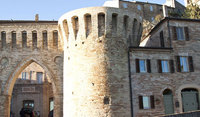Luxury holiday homes become the saviour of Italian architecture

From commercial property investment to the saviour of ancient Italian architecture, it seems that 2015 could be the year of the new Italian renaissance so far as real estate is concerned.
Just as the Renaissance was in part driven by the foreign influences of Greek scholars and classical texts, it is foreigners who are now driving forward Italy’s property market. Their interest in commercial real estate (led by retail buildings and followed by the office and hospitality sectors) soared in 2014, with Cushman & Wakefield reporting an expected commercial real estate investment volume during the year of around €5 billion – 20% higher than the previous year.
Foreign investors are the most active in the market and are expected to drive forward a further 20% increase during 2015, having tired of other European markets. As Deutsche Bank managing director Massimo Saletti, explains,
“There is a general feeling that other markets have already been explored from a valuation and opportunity standpoint, and Italy is an obvious choice for capital at competitive pricing levels.”
It is not just commercial real estate that is behind the new Italian property renaissance. Residential property is also playing its part. While commercial buildings are bringing in the money and stealing the limelight, a quite movement is underway that is seeing foreign investors becoming the saviours of Italian architecture.
While the Italian government is selling off castles and other ancient assets in a bid to raise some quick cash, factional ownership company Appassionata is taking a different approach by lovingly and sympathetically restoring old properties and turning them into luxury holiday homes.
Casa Tre Archi, Appassionata’s latest project, is a stunning property that is actually built into the town walls of the medieval hilltop settlement of Petritoli in Le Marche – one of the turrets is a feature wall in the property’s living room. Appassionata has breathed life back into the ancient dwelling, as founder Dawn Cavanagh-Hobbs, comments,
“Italy has so many fantastic old buildings that are gradually crumbling away to dust. It is heart-breaking to see so much history being lost and I am delighted that Appassionata can play a part in saving some of these architectural gems.”
Casa Tre Archi is the company’s third shared ownership project. They have previously resurrected a cluster of tumbledown farm buildings, transforming them into two luxury country houses, along with a working estate. Dawn and her team have also restored a local palazzo, which has become the family home.
“Restoring the palazzo was such an incredible experience,” recalls Dawn. “The roof was partially caved in and one more winter would probably have been the end of the property altogether. Since we began work there, several of the locals have popped in and thanked us for saving it, regaling us with tales from their youth of lively social gatherings that took place there.”
With work on the palazzo and Casa Tre Archi (shares of which are available from £65,000 for five weeks’ usage per year) now complete, Appassionata are looking for their next project and are determined to show that world that shared ownership holiday homes can be the saviour that neglected Italian architecture so badly needs.
For more information, visit appassionata.com.

